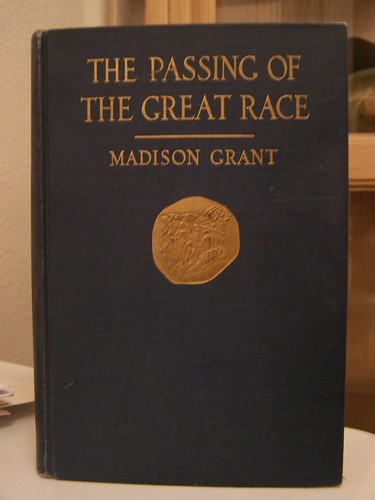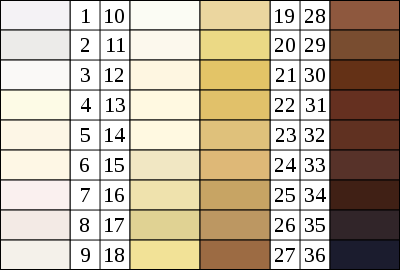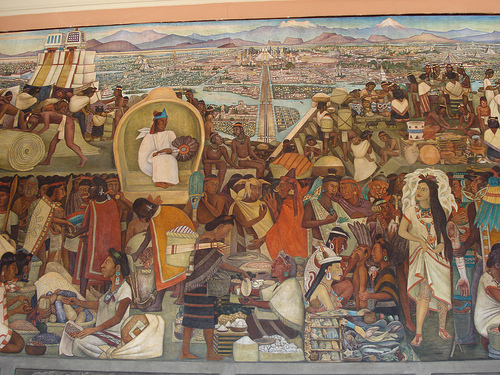
Madison Grant’s The Passing of the Great Race, published in 1916, is a classic in race studies. Below, a few excerpts from the second chapter, “The Physical Basis of Race” (no ellipsis added):
These physical characters are to all intents and purposes immutable and they do not change during the lifetime of a language or an empire. The skull shape of the Egyptian fellaheen, in the unchanging environment of the Nile Valley, is absolutely identical in measurements, proportions and capacity with skulls found in the predynastic tombs dating back more than six thousand years.
There exists today a widespread and fatuous belief in the power of environment, as well as of education and opportunity to alter heredity, which arises from the dogma of the brotherhood of man, derived in its turn from the loose thinkers of the French Revolution and their American mimics. Such beliefs have done much damage in the past and if allowed to go uncontradicted, may do even more serious damage in the future. Thus the view that the Negro slave was an unfortunate cousin of the white man, deeply tanned by the tropic sun and denied the blessings of Christianity and civilization, played no small part with the sentimentalists of the Civil War period and it has taken us fifty years to learn that speaking English, wearing good clothes and going to church do not transform a Negro into a white man. Nor was a Syrian or Egyptian freedman transformed into a Roman by wearing a toga and applauding his favorite gladiator in the amphitheatre. Americans will have a similar experience with the Polish Jew, whose dwarf stature, peculiar mentality and ruthless concentration on self-interest are being engrafted upon the stock of the nation.
Recent attempts have been made in the interest of inferior races among our immigrants to show that the shape of the skull does change, not merely in a century, but in a single generation. In 1910, the report of the anthropological expert of the Congressional Immigration Commission gravely declared that a round skull Jew on his way across the Atlantic might and did have a round skull child; but a few years later, in response to the subtle elixir of American institutions as exemplified in an East Side tenement, might and did have a child whose skull was appreciably longer; and that a long skull south Italian, breeding freely, would have precisely the same experience in the reverse direction. In other words the Melting Pot was acting instantly under the influence of a changed environment.
What the Melting Pot actually does in practice can be seen in Mexico, where the absorption of the blood of the original Spanish conquerors by the native Indian population has produced the racial mixture which we call Mexican and which is now engaged in demonstrating its incapacity for self-government. The world has seen many such mixtures and the character of a mongrel race is only just beginning to be understood at its true value.
It must be borne in mind that the specializations which characterize the higher races are of relatively recent development, are highly unstable and when mixed with generalized or primitive characters tend to disappear. Whether we like to admit it or not, the result of the mixture of two races, in the long run, gives us a race reverting to the more ancient, generalized and lower type. The cross between a white man and an Indian is an Indian; the cross between a white man and a Negro is a Negro; the cross between a white man and a Hindu is a Hindu; and the cross between any of the three European races and a Jew is a Jew.
In the crossing of the blond and brunet elements of a population, the more deeply rooted and ancient dark traits are prepotent or dominant. This is matter of every-day observation and the working of this law of nature is not influenced or affected by democratic institutions or by religious beliefs. Nature cares not for the individual nor how he may be modified by environment. She is concerned only with the perpetuation of the species or type and heredity alone is the medium through which she acts.
 Eye color is of very great importance in race determination because all blue, gray or green eyes in the world today came originally from the same source, namely, the Nordic race of northern Europe. This light colored eye has appeared no-where else on earth, is a specialization of this subspecies of man only and consequently is of extreme value in the classification of European races. Dark colored eyes are all but universal among wild mammals and entirely so among the primates, man’s nearest relatives. It may be taken as an absolute certainty that all the original races of man had dark eyes.
Eye color is of very great importance in race determination because all blue, gray or green eyes in the world today came originally from the same source, namely, the Nordic race of northern Europe. This light colored eye has appeared no-where else on earth, is a specialization of this subspecies of man only and consequently is of extreme value in the classification of European races. Dark colored eyes are all but universal among wild mammals and entirely so among the primates, man’s nearest relatives. It may be taken as an absolute certainty that all the original races of man had dark eyes.
One subspecies of man and one alone specialized in light colored eyes. This same subspecies also evolved light brown or blond hair, a character far less deeply rooted than eye color, as blond children tend to grow darker with advancing years and populations partly of Nordic extraction, such as those of Lombardy, upon admixture with darker races lose their blond hair more readily than their light colored eyes. In short, light colored eyes are far more common than light colored hair. In crosses between Alpines and Nordics, the Alpine stature and the Nordic eye appear to prevail.
Blond hair also comes everywhere from the Nordic subspecies and from nowhere else. Whenever we find blondness among the darker races of the earth we may be sure some Nordic wanderer has passed that way. When individuals of perfect blond type occur, as sometimes in Greek islands, we may suspect a recent visit of sailors from a passing ship but when only single characters remain spread thinly, but widely, over considerable areas, like the blondness of the Atlas Berbers or of the Albanian mountaineers, we must search in the dim past for the origin of these blurred traits of early invaders.
The range of blond hair color in pure Nordic peoples runs from flaxen and red to shades of chestnut and brown. The darker shades may indicate crossing in some cases, but absolutely black hair certainly does mean an ancestral cross with a dark race—in England with the Mediterranean race.
It must be clearly understood that blondness of hair and of eye is not a final test of Nordic race. The Nordics include all the blonds, and also those of darker hair or eye when possessed of a preponderance of other Nordic characters. In this sense the word “blond” means those lighter shades of hair or eye color in contrast to the very dark or black shades which are termed brunet. The meaning of “blond” as now used is therefore not limited to the lighter or flaxen shades as in colloquial speech.
In England among Nordic populations there are large numbers of individuals with hazel brown eyes joined with the light brown or chestnut hair which is the typical hair shade of the English and Americans. This combination is also common in Holland and Westphalia and is frequently associated with a very fair skin. These men are all of “blond” aspect and constitution and consequently are to be classed as members of the Nordic race.
In Nordic populations the women are, in general, lighter haired than the men, a fact which points to a blond past and a darker future for those populations. Women in all human races, as the females among all mammals, tend to exhibit the older, more generalized and primitive traits of the past of the race. The male in his individual development indicates the direction in which the race is tending under the influence of variation and selection.
The color of the skin is a character of importance but one that is exceedingly hard to measure as the range of variation in Europe between skins of extreme fairness and those that are exceedingly swarthy is almost complete. The Nordic race in its purity has an absolutely fair skin and is consequently the white man par excellence.
Many members of the Nordic race otherwise apparently pure have skins, as well as hair, more or less dark, so that the determinative value of this character is uncertain.
 There can be no doubt that the quality of the skin and the extreme range of its variation in color from black, brown, red, yellow to ivory-white are excellent measures of the specific or subgeneric distinctions between the larger groups of mankind but in dealing with European populations it is sometimes difficult to correlate the shades of fairness with other physical characters.
There can be no doubt that the quality of the skin and the extreme range of its variation in color from black, brown, red, yellow to ivory-white are excellent measures of the specific or subgeneric distinctions between the larger groups of mankind but in dealing with European populations it is sometimes difficult to correlate the shades of fairness with other physical characters.
The Mediterranean race is everywhere marked by a relatively short stature, sometimes greatly depressed, as in south Italy and in Sardinia, and also by a comparatively light bony framework and feeble muscular development.
The Alpine race is taller than the Mediterranean, although shorter than the Nordic, and is characterized by a stocky and sturdy build. The Alpines rarely, if ever, show the long necks and graceful figures so often found in the other two races.
In some cases where these three European races have become mixed stature seems to be one of the first Nordic characters to vanish.
These four characters, skull shape, eye color, hair color and stature, are sufficient to enable us to differentiate clearly between the three main subspecies of Europe, but if we wish to discuss the minor variations in each race and mixtures between them, we must go much further and take up other proportions of the skull than the cephalic index, as well as the shape and position of the eyes, the proportions and shape of the jaws, the chin and other features.
The nose is an exceedingly important character. The original human nose was, of course, broad and bridgeless. This trait is shown clearly in newborn infants who recapitulate in their development the various stages of the evolution of the human genus. A bridgeless nose with wide, flaring nostrils is a very primitive character and is still retained by some of the larger divisions of mankind throughout the world. It appears occasionally in white populations of European origin but is everywhere a very ancient, generalized and low character.
The high bridge and long, narrow nose, the so-called Roman, Norman or aquiline nose, is characteristic of the most highly specialized races of mankind. While an apparently unimportant character, this feature is one of the very best clews to racial origin and in the details of its form, and especially in the lateral shape of the nostrils, is a race determinant of the greatest value.
The lips, whether thin or fleshy or whether clean-cut or everted, are race characters. Thick, protruding, everted lips are very ancient traits and are characteristic of many primitive races. A high instep also has long been esteemed an indication of patrician type while the flat foot is often the test of lowly origin.
The so-called red haired branch of the Nordic race has special characters in addition to red hair, such as a greenish cast of eye, a skin of delicate texture tending either to great clarity or to freckles and certain peculiar temperamental traits. This was probably a variety closely related to the blonds and it first appears in history in association with them.
While the three main European races are the subject of this book and while it is not the intention of the author to deal with the other human types, it is desirable in connection with the discussion of this character, hair, to state that the three European subspecies are subdivisions of one of the primary groups or species of the genus Homo which, taken together, we may call the Caucasian for lack of a better name.
Outside of the three European sub-species the greater portion of the genus Homo can be roughly divided into the Negroes and Negroids, and the Mongols and Mongoloids.
The former apparently originated in south Asia and entered Africa by way of the northeastern corner of that continent. Africa south of the Sahara is now the chief home of this race, though remnants of Negroid aborigines are found throughout south Asia from India to the Philippines, while the very distinct black Melanesians and the Australoids lie farther to the east and south.
The Mongoloids include the round skulled Mongols and their derivatives, the Amerinds or American Indians. This group is essentially Asiatic and occupies the centre and the eastern half of that continent.
A description of these Negroids and Mongoloids and their derivatives, as well as of certain aberrant species of man, lies outside the scope of this work.

